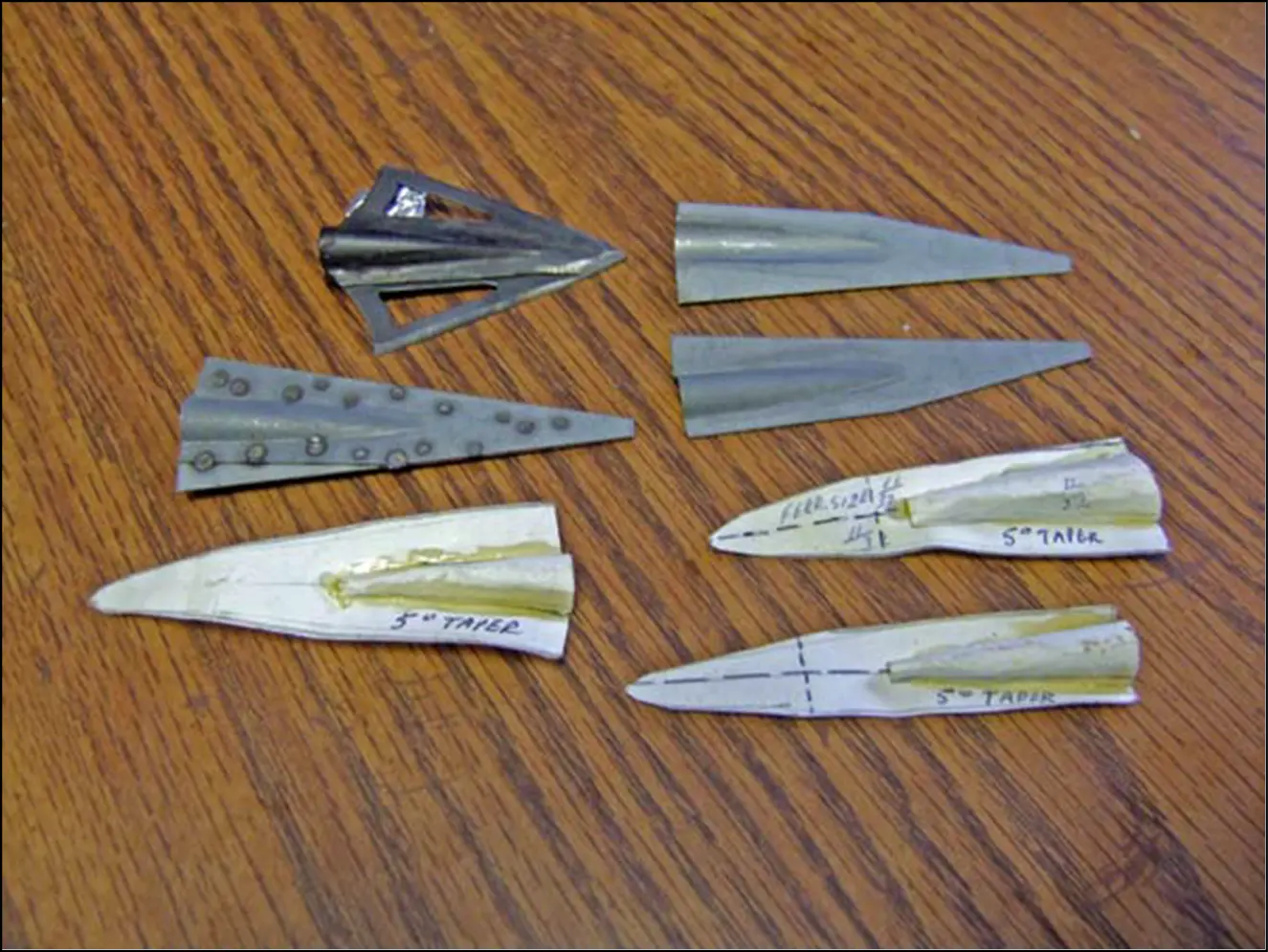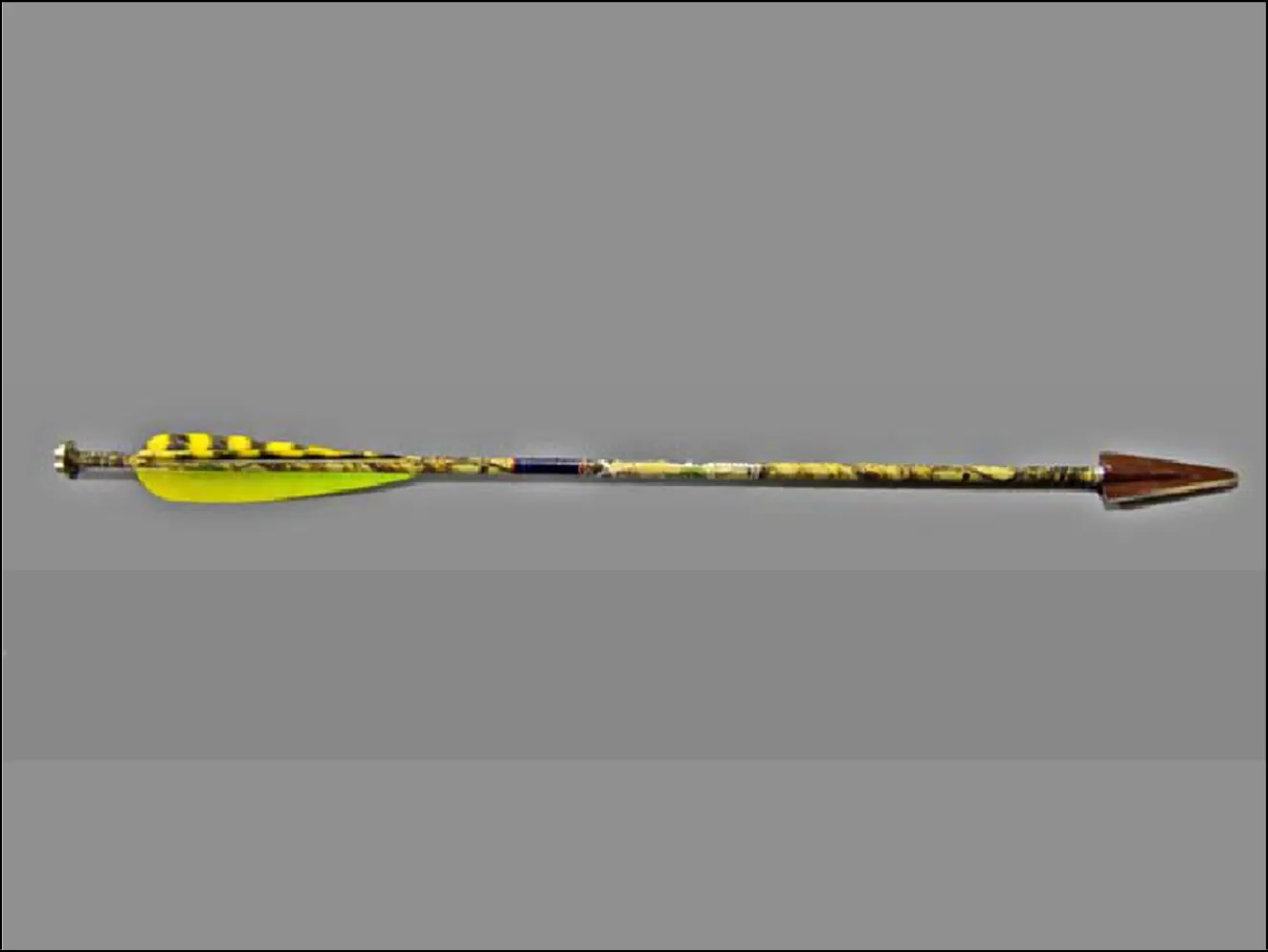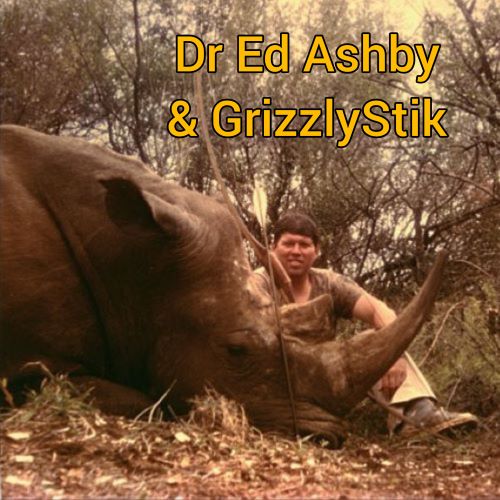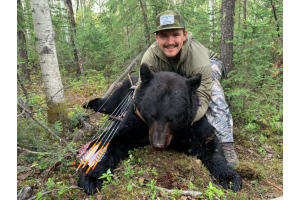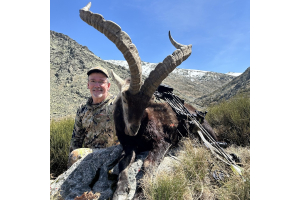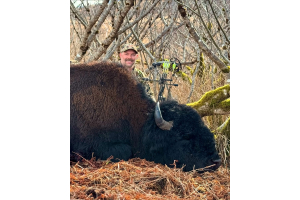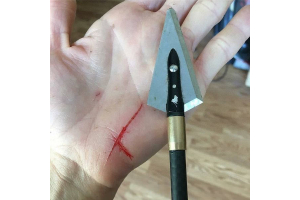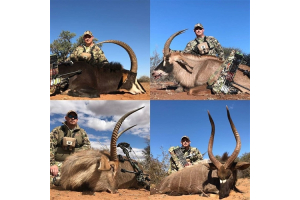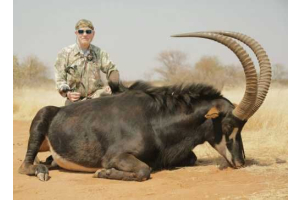Why Single-Bevel Broadheads? By Dr. Ed Ashby
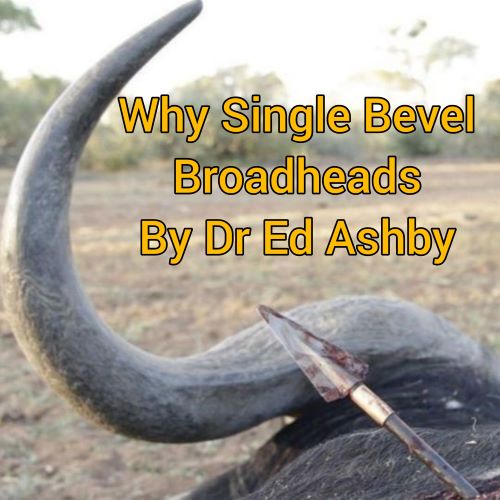
Single-bevel broadheads are not new to the bowhunting scene. Harry Elburg was the first in modern times to manufacture a single-bevel broadhead, and his original Grizzly hit production some three decades ago. But Harry definitely wasn't the first to produce a single-bevel broadhead; I've seen ancient stone points with single-bevels!
Birth of a legend: The prototype mock-ups of Harry Elburg's original Grizzly broadhead, made first from cardboard and then sheet metal. The wide-cut broadhead shown is the Goshawk. Its braised two-piece blade construction provided the inspirational spark, but the Grizzly's design, with single-bevel edge and Tanto tip profile, was all Harry's. From the Grizzly's inception, Harry understood the benefits a single-bevel offered, explaining them in detail the first time I talked to him, nearly
30 years ago. Every benefit Harry described has proven correct!
During the last 25 years, I've intensely studied broadhead design, and how it affects a hunting arrow's terminal performance in tissues; field testing hundreds of different heads in real tissues, dissecting wound channels, and looking at results. It's taken me that long to fully comprehend the 'how and why' of single-bevel broadhead performance and the numerous and remarkable advantages it offers the bowhunter. The most obvious functional difference between single and double-beveled broadheads is the rotation single-bevels induce as the broadhead penetrates.
Everyone knows that arrows rotate in flight, because of the effect of the fletching. Few, however, give arrow rotation any thought beyond that. And why should they? When using a double-beveled broadhead all arrow rotation stops at impact and, unless the broadhead is deviated in some way by impact with hard tissue, such as bone, the arrow penetrates straight through an animal without any rotation. Examination of entrance and exit wounds, and the intervening wound channel, confirms this.
During the flight, the typical arrow makes one complete revolution (360 degrees) in about 60 inches of travel. Several times I've measured the rotational rate exhibited for one specific single-bevel broadhead design; the Modified Grizzly. It's the broadhead I use for most of my hunting. Its single-bevel edges induce one complete revolution in just under 16" of soft-tissue travel (through 'pure meat').
The Modified Grizzly is an altered version of the 190-grain Grizzly El Grande. It is 1" wide, has a blade length of 3.125", a 25-degree right-hand single bevel, a 30-degree cut-on-impact Tanto tip, and a main-blade angle of attack of 7.4 degrees. Its finished weight is 170 grains.
Though many people associate the Modified Grizzly with me and the Study, I can't take credit for its design. If you look at Harry's paper prototypes in the photo above you'll see his conceptual versions; there are three. The two 'narrow versions' bear extreme similarity in length, width, and profile to the Modified Grizzly and the Grizzly Extreme - the two modifications I commonly make to the production model. And for good reason; all those years ago, when Harry first told me what he felt single-bevels could do, I paid attention to everything he said!
What effect does broadhead rotation have during tissue penetration, and why is it an advantage? There are several advantages, but the most obvious is when the arrow penetrates the bone. The bevel-induced rotation tends to cause massive bone breaks; especially in the heavier bone; whereas a double-bevel broadhead simply forces its way directly through, rarely splitting any other than the very lightest of bone. Splitting, rather than piercing bone has demonstrated a major penetration benefit - it lowers drag on the trailing shaft, and test results show that shaft drag is a huge penetration-reducing factor.
Why do single-bevel blades rotate? If you happen to have any kitchen knives with a single-bevel edge, give this a try. While keeping the blade's width absolutely vertical, try cutting a thin slice off a big roast or ham … or even a sizable chunk of cheese or a big tomato. What happens? The knife blade 'walks' to one side; the side opposite the single bevel. The cutting edge is deviated by the pressure the meat (or whatever it is your slicing) is exerting on the blade's bevel – and which isn't being off-set by having an even amount of pressure 'pushing' on the other side of the blade (the side with no bevel).
If that single-beveled knife blade is shoved directly through a slab of meat, the blade does not pass straight through. As the pressure against the bevel forces the blade's edge to deviate one direction, the blade's back edge is forced against the meat, but in the opposing direction; i.e. as the cut 'walks right' the blade's back edge is forced to the left - and the blade rotates. As the blade rotates, its surface area also exerts pressure on the meat.
Where did that pressure the knife blade exerts on the meat come from? It's the same pressure the meat applied to the edge- bevel, being transferred back onto the meat. But there's now a difference in the direction that pressure is being applied; it's at a right angle to the direction of the knife blade's passage through the meat. If a similar single-bevel is added on the back of the knife blade, on the opposite side of the blade's face from the first bevel, the amount of pressure (force) the 'tissue push' generates against the bevels becomes double what it was when only one edge was single-beveled; and the force the blade- flat exerts against the meat at a right angle to its direction of travel is also doubled.
The source and effect of a single-bevel broadhead's rotation are being dwelled upon a bit because most people don't understand it. Most folks appear to believe the single-bevel slices in and pulls the blade to the side. It doesn't. A single-beveled broadhead's rotation is caused by the tissue(s) the blade is penetrating. The blade, and its single bevel, push against the tissues and the tissues pushes back (resistance force).
Because the tissue's 'push' on the broadhead's bevel is not met by any 'tissue push' on the opposite side of that individual blade's edge, the edge is shoved sideways; just as the knife's blade edge was when it made that 'walking cut'. Since a broadhead is piercing the tissue, and both its edges are being forced sideways (in the same direction) the broadhead rotates as it moves forward.
As the broadhead rotates, its face (the blade flat) transmits whatever amount of 'push' the tissue generates on the single bevels right back onto the tissue; over a section of tissue equaling one-half of the broadhead's total surface area, and at a right angle to the direction of arrow penetration. As the broadhead's entire blade width is rotated, that 'right angle pressure' on the tissue is trying to force the tissue apart. The more force applied between tissue and bevel, the greater the blade's torque, and the greater the 'splitting force'.
Succinctly:
(1) It is the tissue's pressure against the bevel which causes the blade to rotate, producing the blade's torque.
(2) The blade-face transmits this force back onto the tissue, but at a right angle to the direction of arrow travel.
(3) The less 'give' the tissue has, the greater the total pressure generated.
(4) The harder the arrow pushes the bevel against the tissue, the harder the tissue's resistance force pushes back against the bevel; and the greater the total pressure generated.
(5) The thicker the tissue is (up to a thickness equaling the blade's length), the greater the total amount of bevel surface that's in contact with the tissue; and the greater the total pressure generated.
(6) The thicker the tissue, the longer the time of contact between the bevel and tissue as the blade passes through; and the greater the total force generated.
The foregoing are important concepts in understanding: (A) How and why single-bevel broadheads split bone; (B) Why splits are more common in heavy bones than they are in lighter bones and; (C) Why a broadhead's ability to penetrate deeply is so important when it's an extremely heavy bone that needs breaking (and this is where having high broadhead mechanical advantage also becomes a very important factor in creating the bone- split).
The simple explanation is: When an arrow tipped with one of those Modified Grizzly heads passes through a bone, the arrow applies force between the single-bevel's taper and the bone. The bone applies a firm resistance back onto the bevel. This induces rotation, which exerts torque; a twisting force. The blade face transmits this torque back to the bone, at a right angle to the arrow's direction of travel. The deeper the broadhead penetrates into the bone, the greater the surface area of the bevel that's in contact with the bone; and the greater the total splitting force generated. When the total applied lateral pressure exceeds the bone's tensile strength, bam - the bone splits or breaks.
And the even simpler one is the bone's pressure against the Modified Grizzly's single-bevel tries to rotate (twist) the entire broadhead about 70 degrees during its 3-1/8" of travel through the bone. This exerts significant lateral pressure. Try sticking even a very thin knife blade through a bone and rotating it just a few degrees; the bone splits big-time, and resistance to penetration drops instantly and dramatically. Since the tissue pressure on the bevel, which causes the rotation and generates the force used to split the bone, is a result of the arrow's force applied to the tissue, does this mean arrow force is being used up in order to break the bone?
Yes. However, breaking a bone in this manner uses up less arrow force than if the arrow has to push its way directly through the bone. That's why a single-bevel broadhead consistently shows far more tissue penetration after passing through the bone than a matching, but double-beveled broadhead.
I think one factor is what energy a single-bevel uses, and how it is used when breaking bones. Single-bevel rotation may be tapping into the rotational energy the arrow carries in flight, applying it usefully in breaking bone. A second factor that I think may be important is that rotational velocity (and the resultant rotational force) is shed more slowly than linear velocity. (During flight, a bullet from a rifled barrel sheds rotational velocity more slowly than linear velocity, and is still revolving in tissues after all forward motion has ceased; due to the gyroscopic effect.) Regardless of what portion(s) of the arrow's kinetic energy the force for splitting bones is derived from, the consistent penetration gain they show over matching broadheads/arrows provides empirical proof that single-bevel broadheads use up less arrow energy and force to breach bones than do matching-profile single-beveled broadheads.
Many who've never closely examined the difference between a single-bevel can make the question that broadhead rotation has many effects. Let's take a look at just what a single bevel does, in both bone and soft tissues. The following photos show what the single-bevel does, why it works, and the results of its many effects during arrow penetration. We'll begin with their splitting- effect on firm tissues.
This first picture shows the setup I use to demonstrate what happens during double-bevel and single-bevel broadhead penetration. It's a short section of shaft that's mounted on a roller-bearing, allowing the arrow to free-rotate as it's pushed through a target. The fletching was left in place because it allows folks to witness the amount of arrow rotation the single-bevel is causing. The broadhead shown here is a 125-grain, right-hand single-beveled Grizzly.
In order to see the splitting effect, a firm but brittle (prone to fracture) target is best. Things such as foam and paper don't exert firm enough pressure against the bevel and tend to be compressed or pushed aside. What's needed is something substantially solid, so the medium can exert firm pressure against the bevel.
It's the differing directional pressure exerted onto the bevel by the medium itself that causes the rotation, which, in turn, allows the blade to exert torque onto the object being penetrated. How 'solid' that tissue is has an effect on the amount of rotational force generated. The blade's face transfers whatever amount of force is generated across a large area of the medium, as a laterally-acting force.
In mediums that aren't firm, or don't have much force pushing on the bevel, there won't be as much rotational pressure. In fact, passing through a total vacuum - devoid of matter - there would be no resistance at all on either side of the blade, and a single bevel won't cause any rotation whatsoever! The denser the medium penetrated, the greater the rotational pressure and the more torque it generates. When it comes to generating a bevel-induced split, the firmer the tissue being penetrated the better.
Fortunately, suitable test targets for demonstrating bevel-induced rotation aren't hard to find. I generally like to use something for the 'target' that I can eat after I've 'killed it'. The one I prefer is a common potato, though most any firm fruit or vegetable will work, as will most meat and cheese (avoid the trendy brie and camembert, though – they're way too soft). All the things listed will exhibit the rotation very nicely, and all but the meat will show the splitting effect.
Holding the arrow setup only by the roller bearing, so the arrow can freely rotate, the broadhead is pushed slowly through the potato. I usually do a double-beveled broadhead first, to show how most commonly used broadheads penetrate a firm, brittle structure.
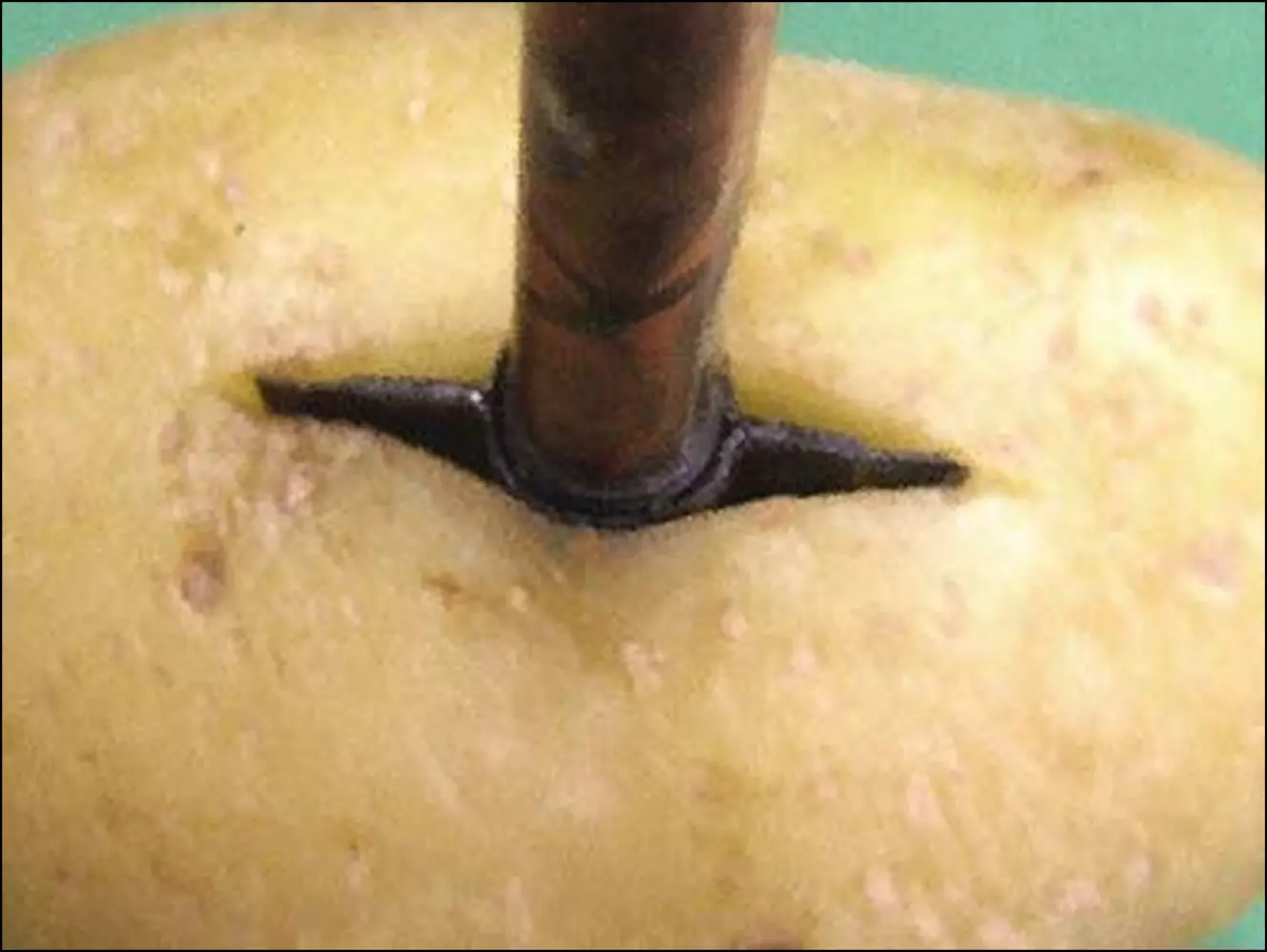 Photo 2
Photo 2
The broadhead shown in Photo 2 is the 189-grain double-beveled Pro Big Game. This one was just pushed into a potato from the side. All it does is make a cut.
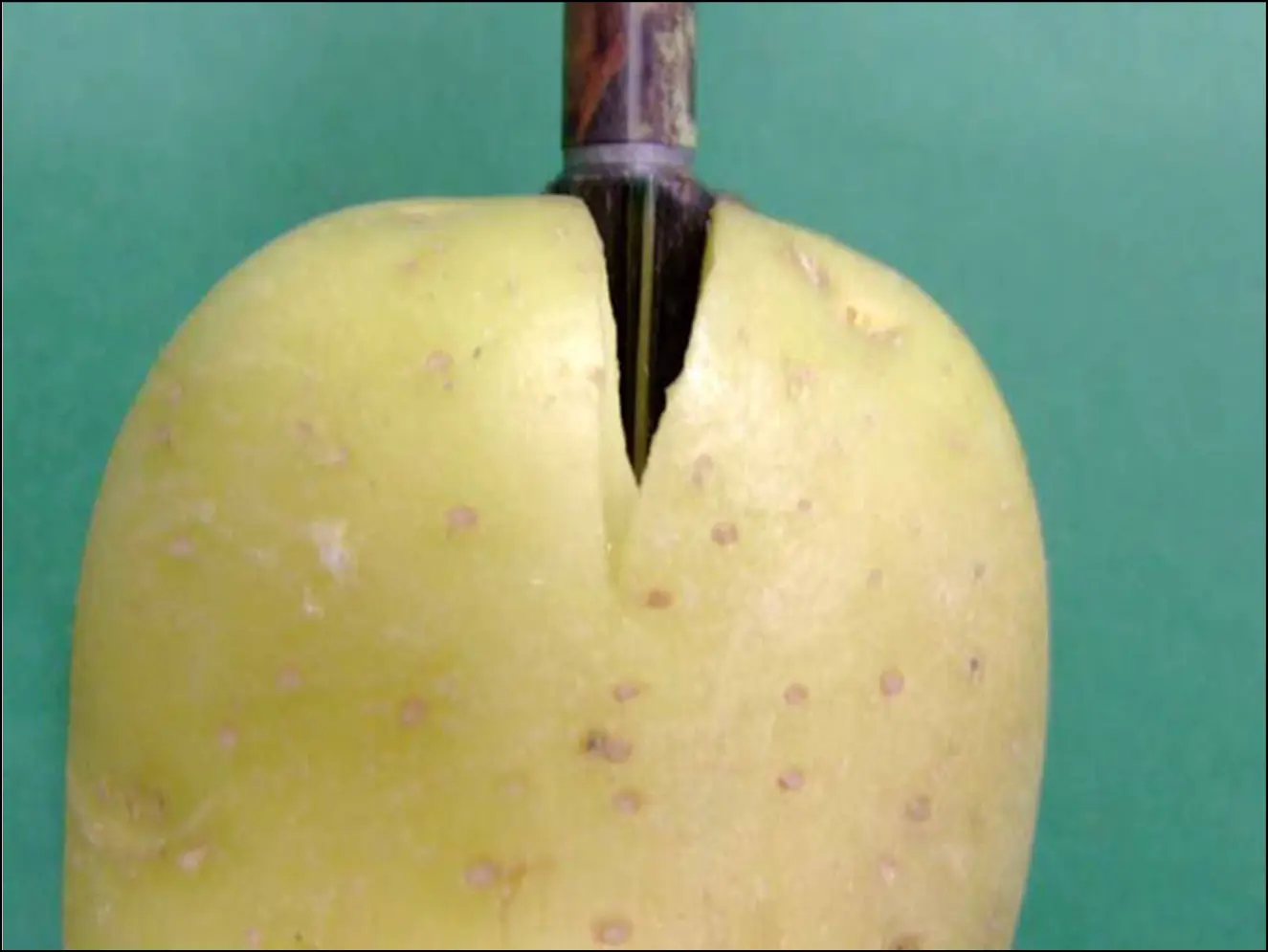 Photo 3
Photo 3
Photo 3 shows the Pro Big Game, mounted on the free-rotating shaft, being pushed lengthwise through a potato about 2 ½" long. Note the slight split, a result of the ferrule and blade's wedge effect. Also note that the blade shows no rotation, in relation to the forming split. At this point, almost a half-inch of the broadhead's 3" long blade's tip is already protruding from the potato's other end.
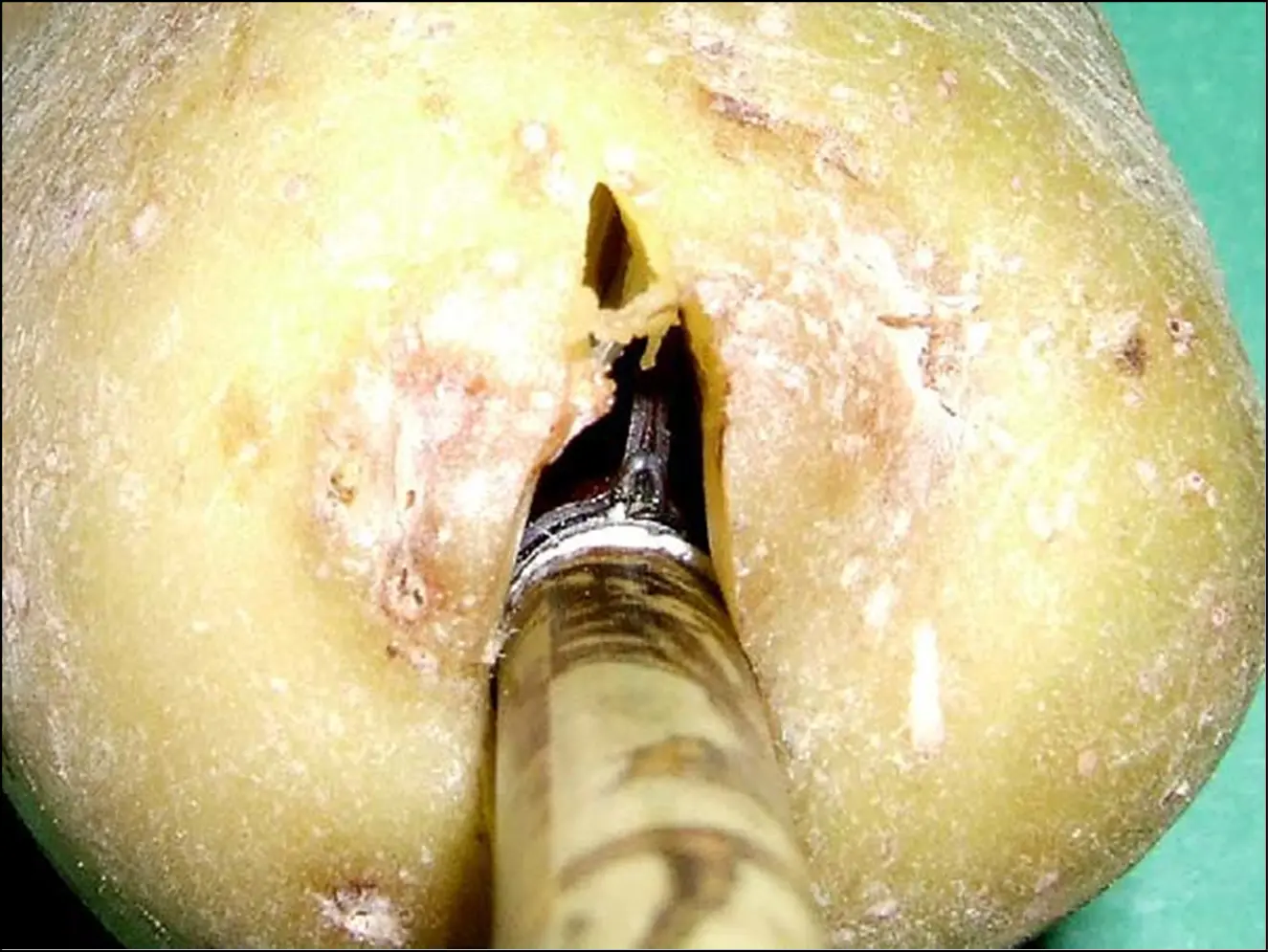
Photo 4a
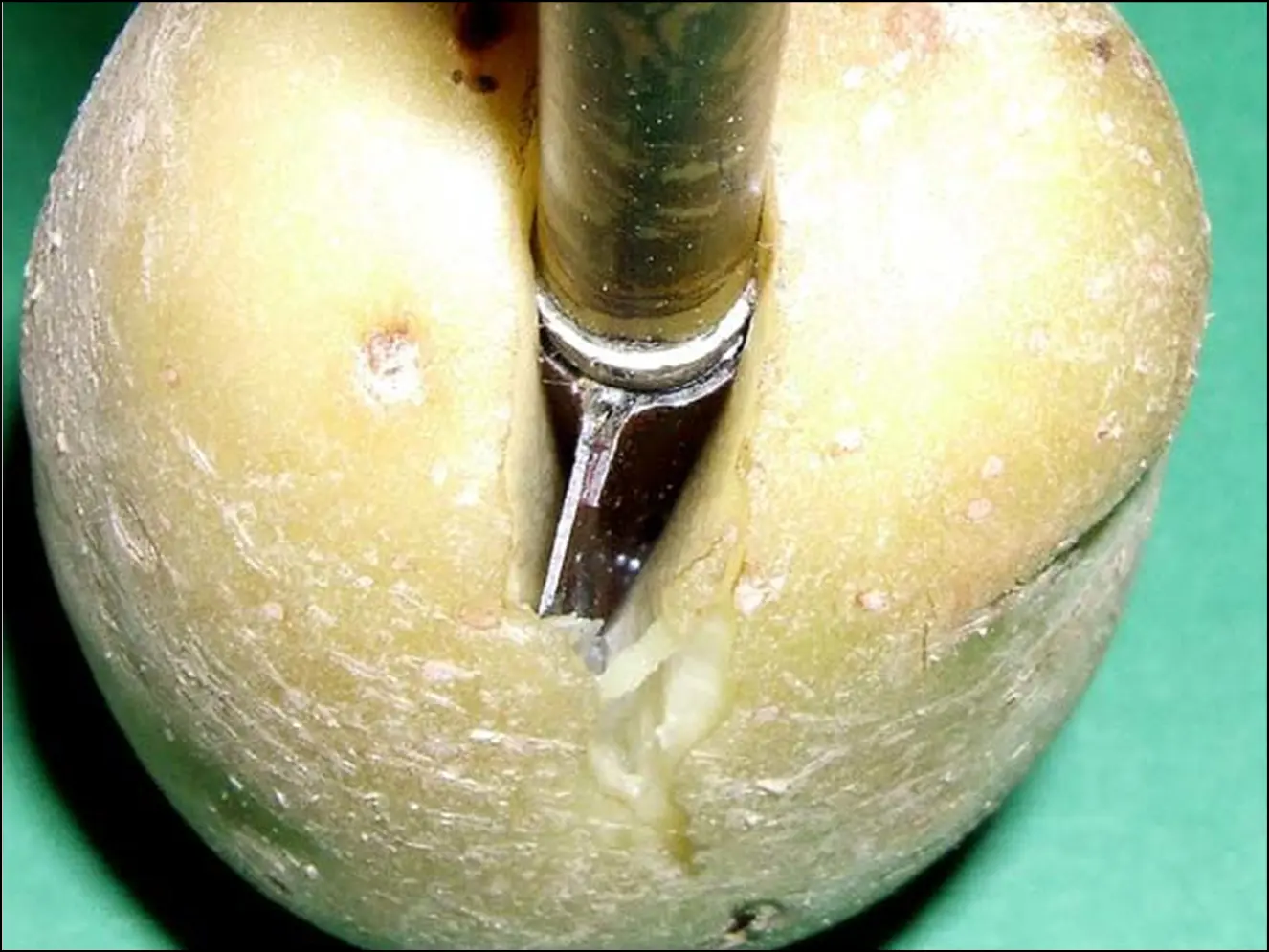 Photo 4b
Photo 4b
Photos 4A and 4B show the 125-grain Grizzly on the free-rotation setup, being forced through a like-size potato. Note what the blade is doing. The potato's 'tissue' is pressing against the blade's single bevels, forcing the head to 'twist'. The broadhead's blade face is transmitting that pressure; pushing against opposing sides of the potato's developing split, forcing the potato's 'halves' away from each other. Note the split beginning to form, already almost halfway down the potato. This broadhead is shorter than the Pro Big game, and its tip hasn't quite reached the other end of the potato yet.
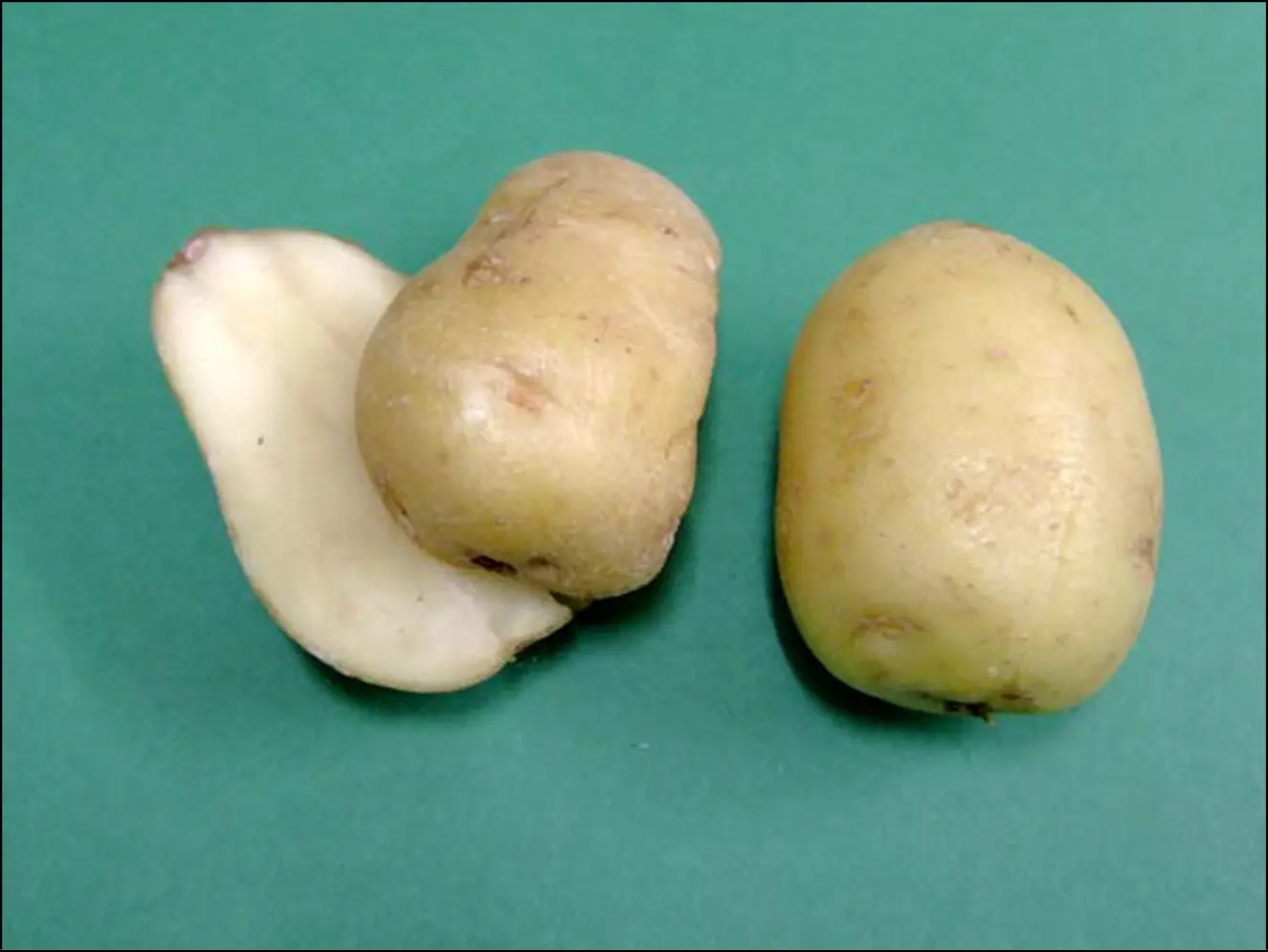 Photo 5
Photo 5
And here's the routine result of the potato tests. The smaller, single-beveled Grizzly caused the potato (left) to split completely in two by the time the head's trailing edge was halfway through. Though the larger Pro Big Game (it's for a 23/64" shaft) has a 4.2% larger ferrule diameter and a 9.1% wider cut, it passed through without splitting the potato apart, making only small splits at each end. So what does bevel-induced lateral pressure mean when it comes to real bone? Here are some examples.
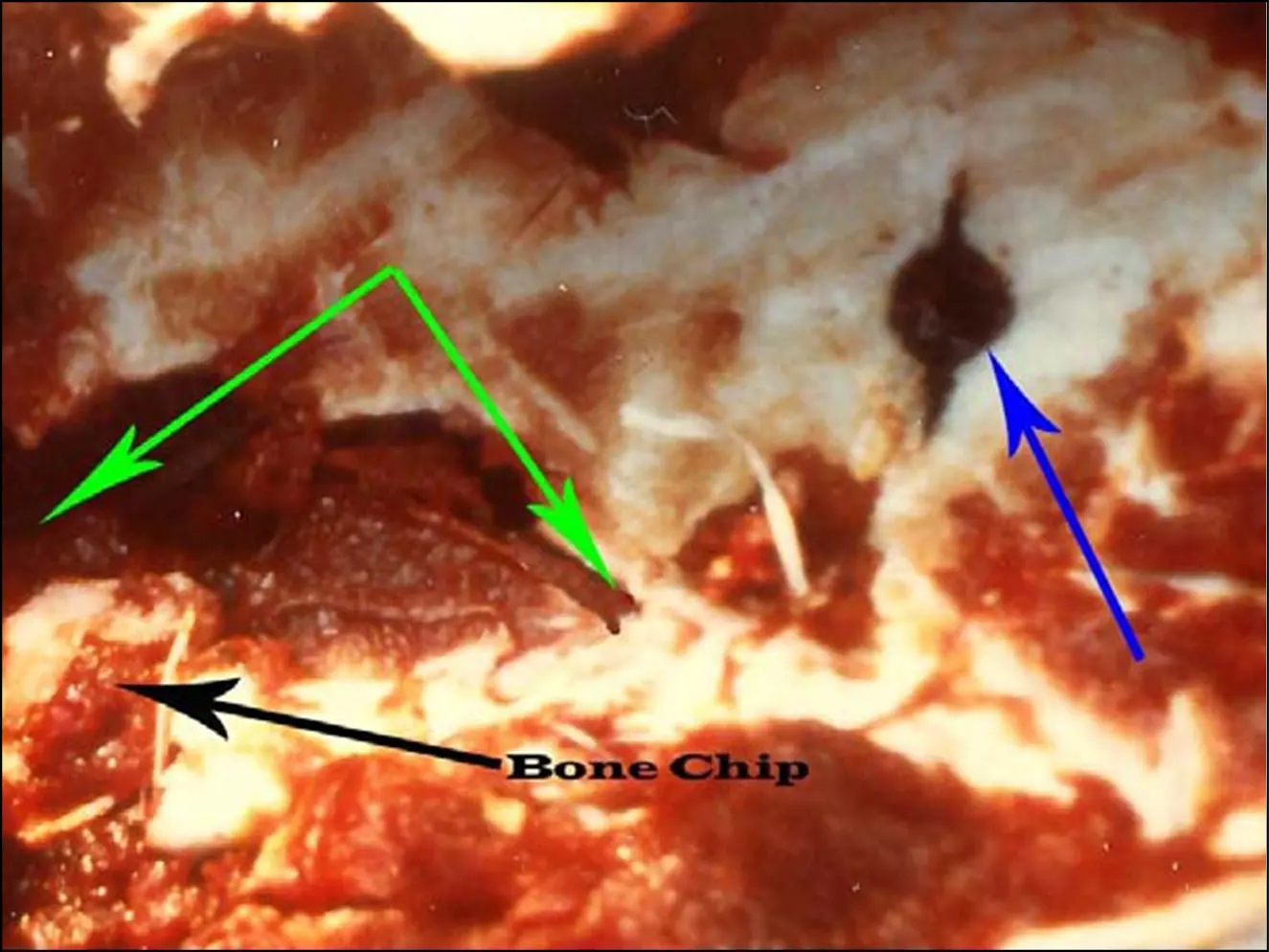 Photo 6
Photo 6
Photo 6 shows a section of heavy zebra scapula that's been penetrated by both a single and double bevel broadhead having nearly identical dimensions; both have a 1" cut-width, while one is 3" long and the other 3.125". Both arrows are from the same bow and each had the same type of shaft, with arrow mass differing by only 10 grains. The double-beveled 160-grain Howard Hill broadhead (blue arrow) punched a neat hole. The single-bevel Modified Grizzly (green arrows – and yes, that's all one hole) busted a big chunk of bone away (the black arrow is pointing to one big piece of it).
In Photo 6, which of the resulting holes do you think will allow the arrow's trailing shaft to pass through this scapula most easily? Which arrow do you think used up more of its force during bone penetration? Which will show the greatest overall penetration? The actual outcomes were a thorax-traversing hit for the Modified Grizzly (with exit wound), while the Howard Hill barely lacerated one lung, having hung up in the on-side rib.
Just as with the potato, the single-beveled broadhead's 'twisting force' created a large break in the bone, early in its penetration. As soon as that happened, CRACK … the bone's structural integrity was breached and resistance to penetration immediately dropped. The arrow expended less force breaching the bone, retaining more force that it could apply to penetrating underlying tissues. The bigger hole through the bone meant less shaft drag too, saving even more arrow force for deeper penetration. These are the precise reasons single-bevel broadheads consistently show a substantial gain in average penetration when heavy bone is hit when compared to identical profile broadheads having double-bevels, and tested side-by-side on identical arrows at the same level of impact force.
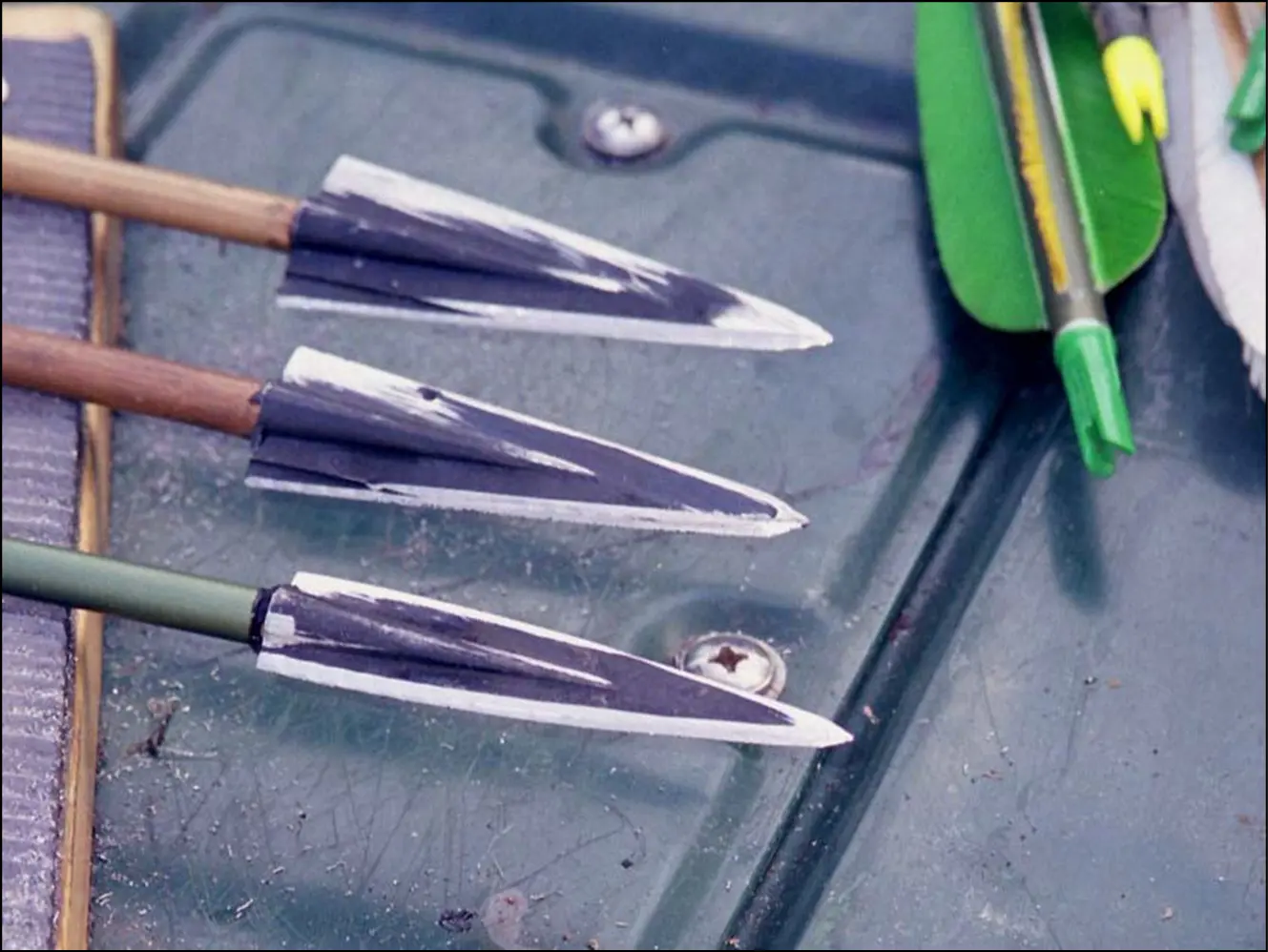 Photo 7
Photo 7
Shown in Photo 7 are the three versions of the 190-grain Grizzly El Grande that I commonly use, both in testing and when hunting. The uppermost one is the standard 190 grain, modified to a COI Tanto tip and with the edge bevel changed to 25 degrees. In the middle, the Modified Grizzly; 1" wide, reduced blade-taper and a COI Tanto tip. At the bottom, the Grizzly Extreme; 11/16" wide, blade taper further reduced, and the COI Tanto tip. These are shown for reference. Note the similarity to Harry's three original paper mock-ups, shown in the first photo.
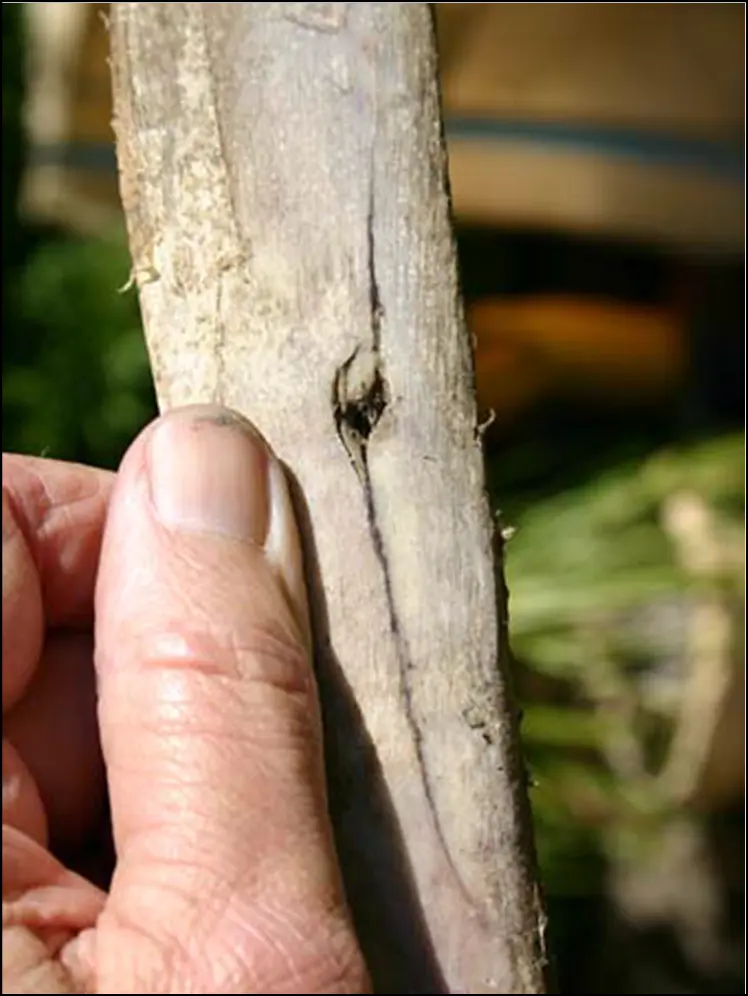 Photo 8
Photo 8
Photo 8 is a cleaned and bleached buffalo rib, showing a 4" bone split made by the very narrow, 11/16" wide Grizzly Extreme.
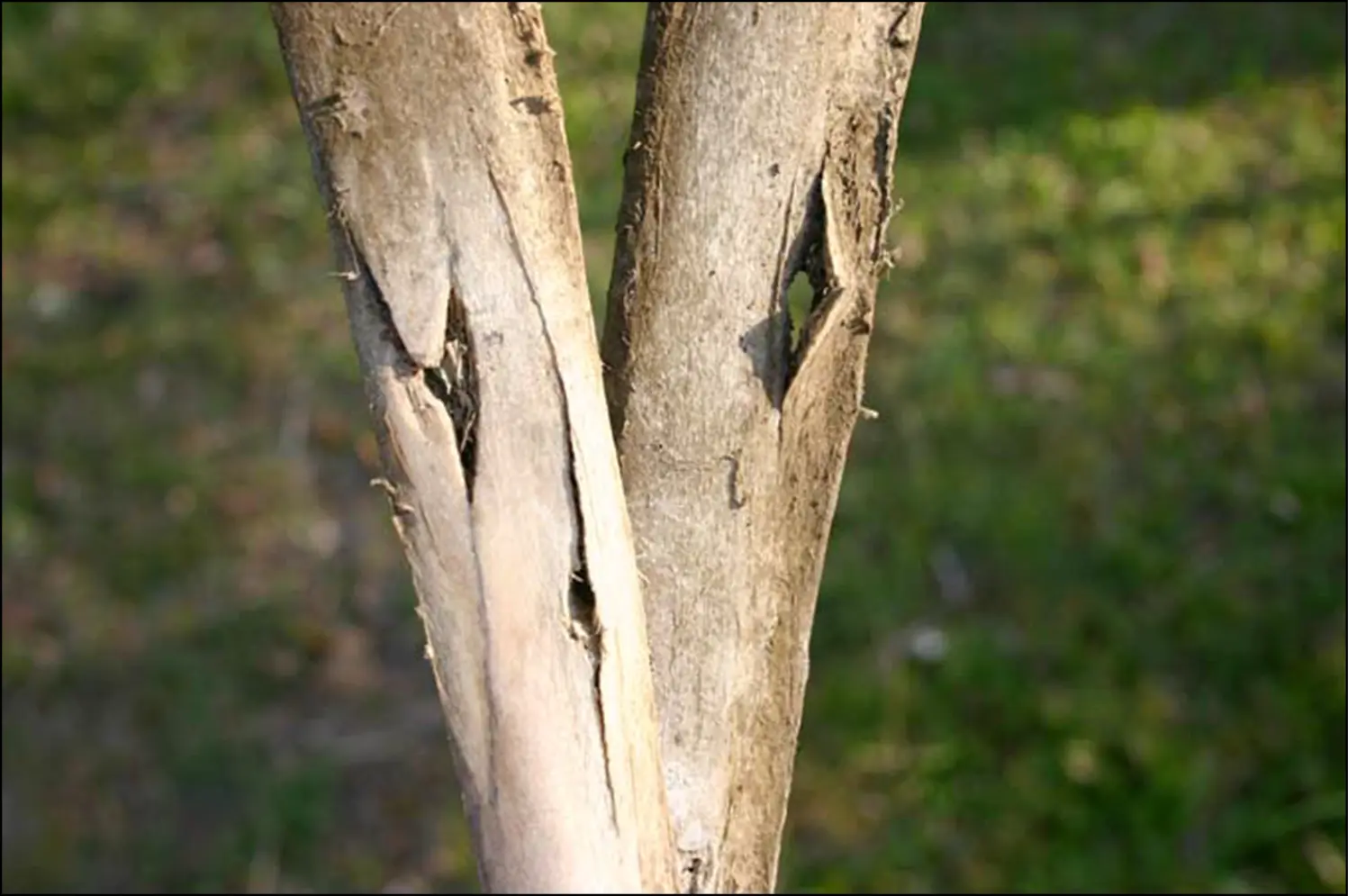 Photo 9
Photo 9
Here's the same bone (right) shown with a similar rib through which a very wide, double-beveled Deadhead passes (left). Note the highly visible bevel-induced rotation shown by the Extreme.
 Photo 10
Photo 10
Photo 10 shows the exit side of two buffalo ribs. The one on the right is from the Deadhead shown above. The rib on the left shows the exits of a Modified Grizzly (upper) and the Grizzly Extreme (lower). Such large bone splits are the norm for single-bevel broadheads. Large bone splits are an extremely rare occurrence with any double-beveled broadhead.
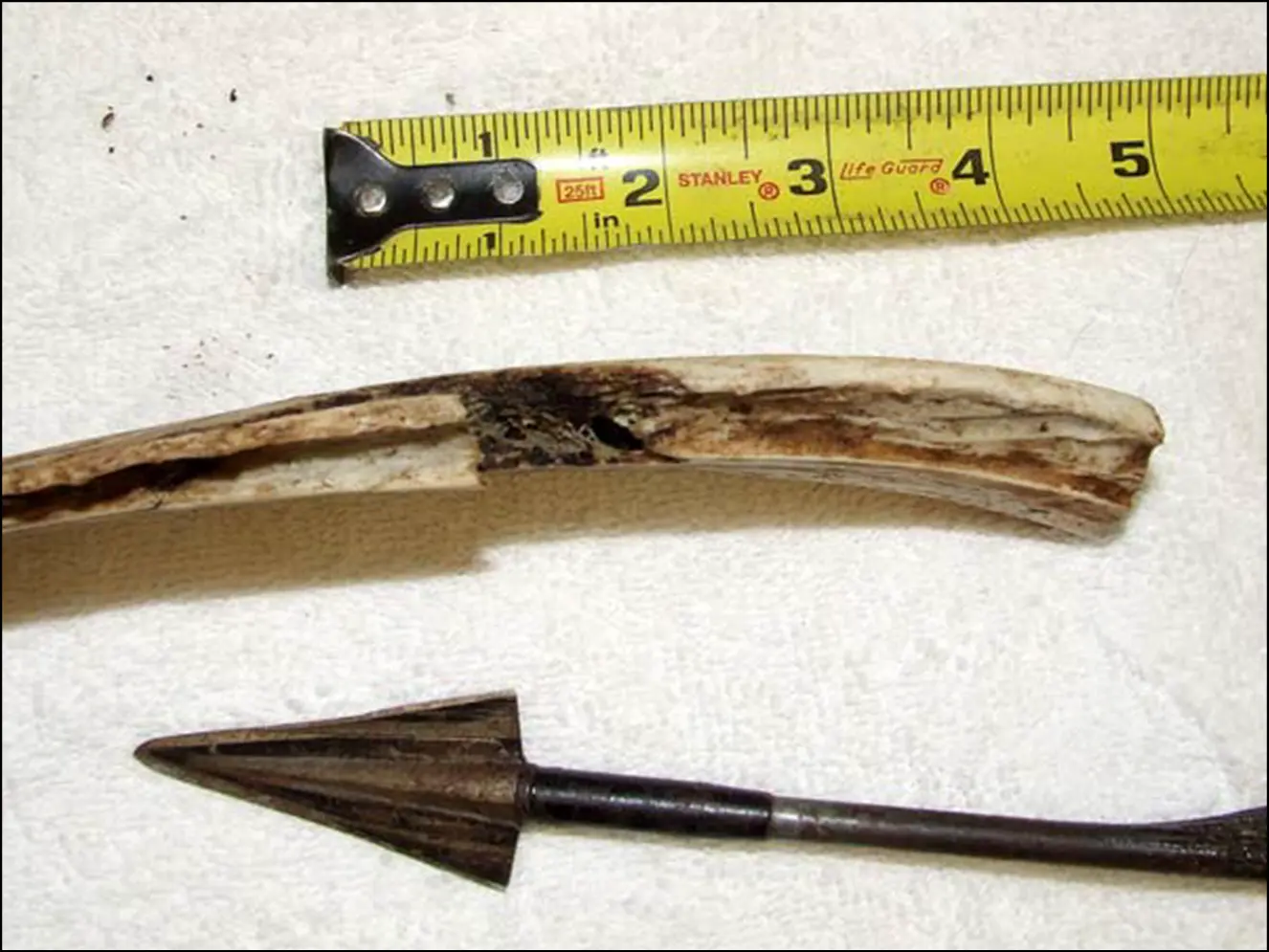 Photo 11
Photo 11
In Photo 11 note the rib thickness of mature, trophy-size buffalo bulls. This rib is from a bull killed by Doug Chase. The broadhead is a custom single-bevel STOS and was used on an Extreme FOC carbon arrow from a 70#@31" DAS recurve. It also achieved an exit wound, with almost a foot of off-side arrow protrusion.
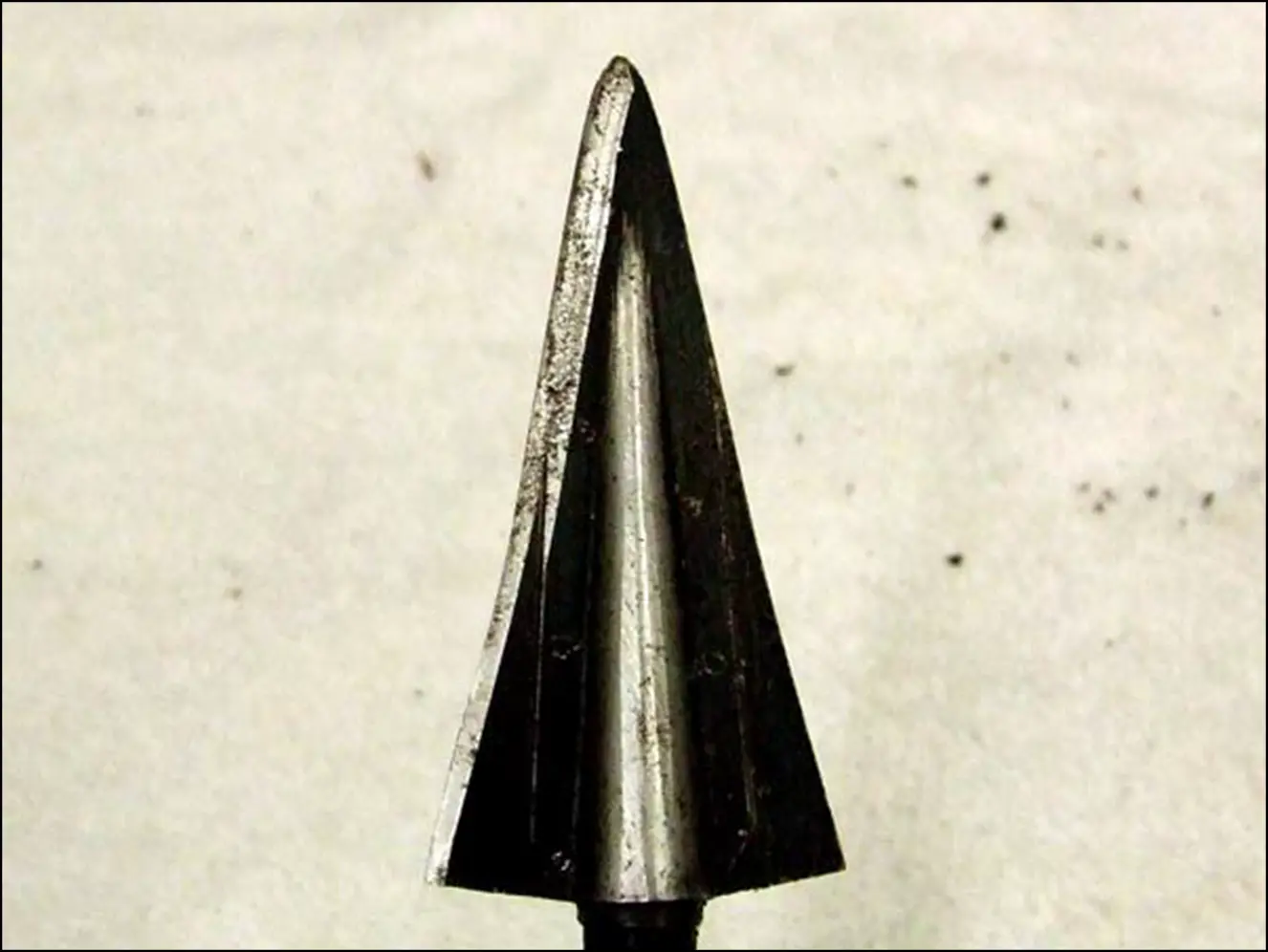 Photo 12
Photo 12
Photo 12 shows Doug's left single-bevel STOS, after use on the buffalo.
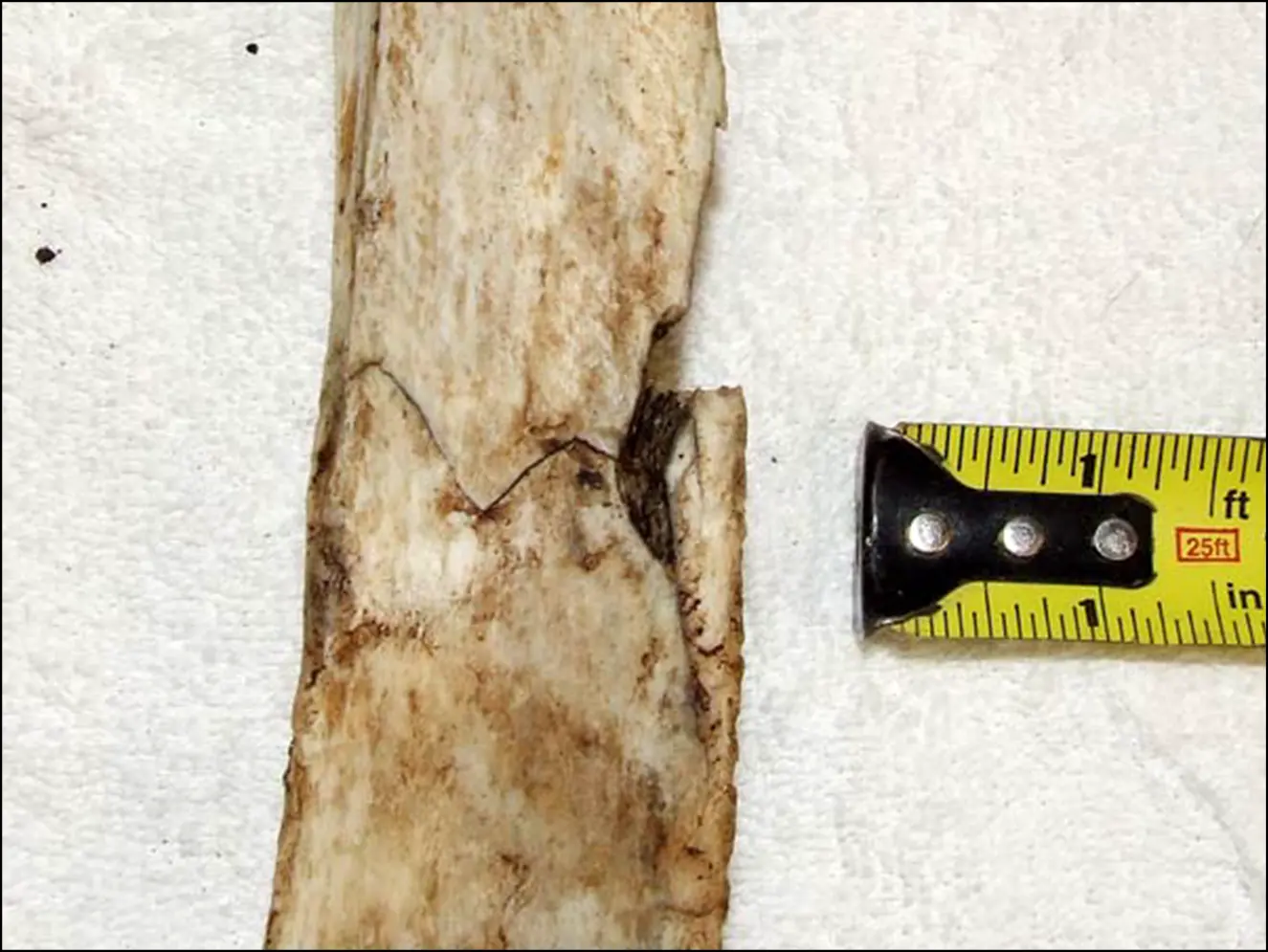 Photo 13
Photo 13
Here's the impact side of the rib shown in Photo 11. There's a long lengthwise split with a big chunk of rib missing and a sizable crack completely across the half-inch thick rib! Was this an isolated occurrence?
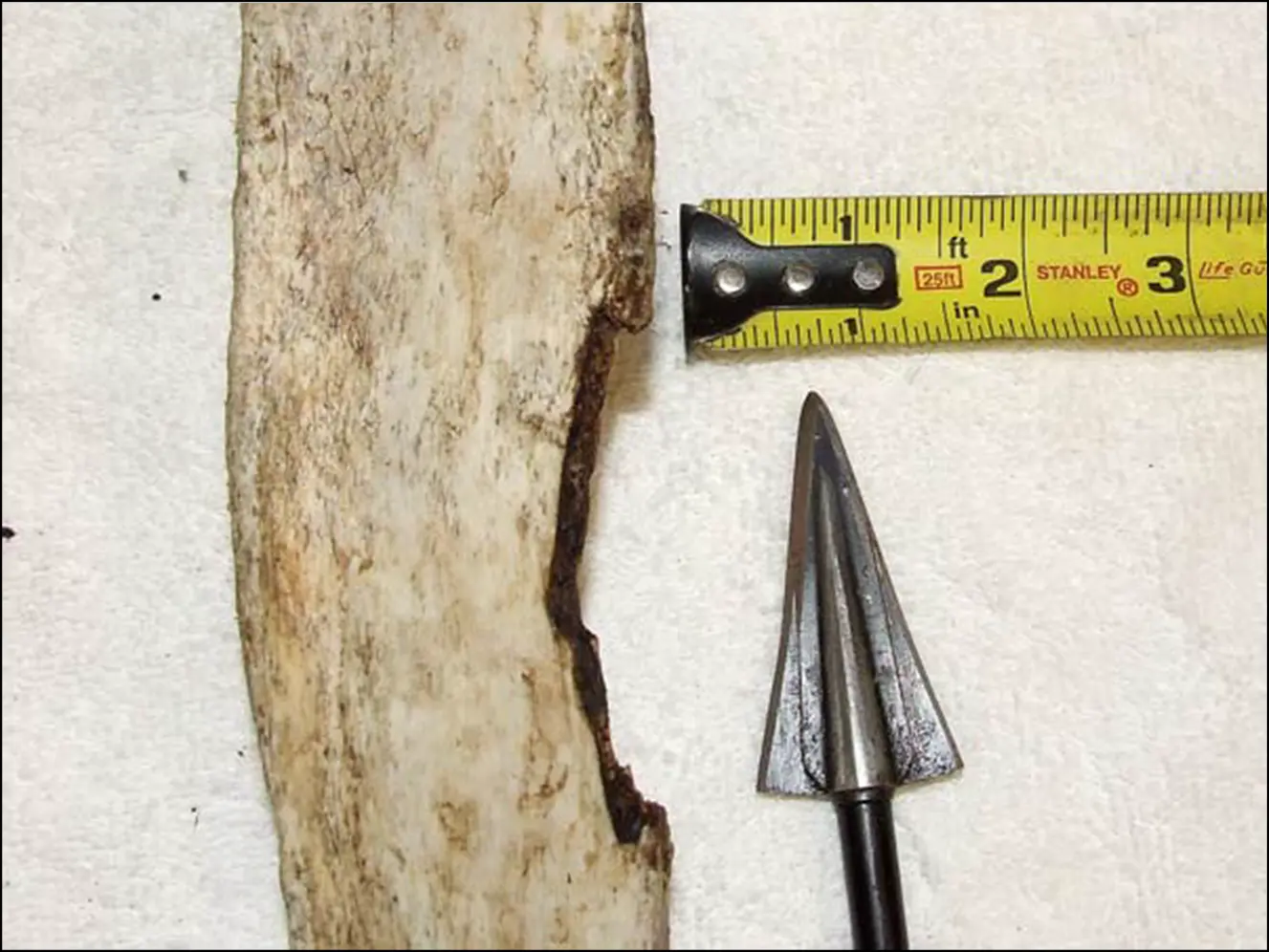 Photo 14
Photo 14
Not hardly! This is a rib from the other trophy buffalo bull Doug took on the same hunt. Broadhead, arrow setup, and bow were the same – as was the outcome; a big rib split with a chunk of bone broken away, and an exit wound with several inches of arrow protruding from it.
If the following photos look familiar, it's because I've used them before. They are among the more dramatic examples of massive bone splits I've encountered with single-bevel broadheads and are most notable because they occurred on extremely heavy scapulas. Most large bone breaks occur on long bones; ribs, humerus, femur, etcetera - or smaller size, but very dense bones; vertebrae, and ball joints. Impacts with flat- bones, like the scapula, more often end up with holes, like that shown in Photo 6, or just S-shaped holes with radiating cracks, like that in Photo 8's buffalo rib.
The thinner the bone, the less likely you'll see a massive hole or split. On thin bone, you'll more commonly see small cracks develop around the single-bevel's hole or radiating from the ends of the S-cut. These tiny cracks relieve the torque pressure before a major 'blow-out' can occur. They not only relieve pressure on the bone, but they also relieve bone pressure against the broadhead and shaft, allowing easier penetration. The pressure reduction from small cracks may not be as great as it would be with a large break, but it still represents a very significant reduction in penetration resistance.
The thin-bone cracks are common because lighter, thinner bones induce 'less push' against the single-bevel, producing a slower developing and less forceful torque than thicker, heavier bones. The heavier the bone the more likely it is to split or snap rather than develop small, pressure-relieving cracks. Single-bevel edges become more important, and more effective, as the bone becomes thicker.
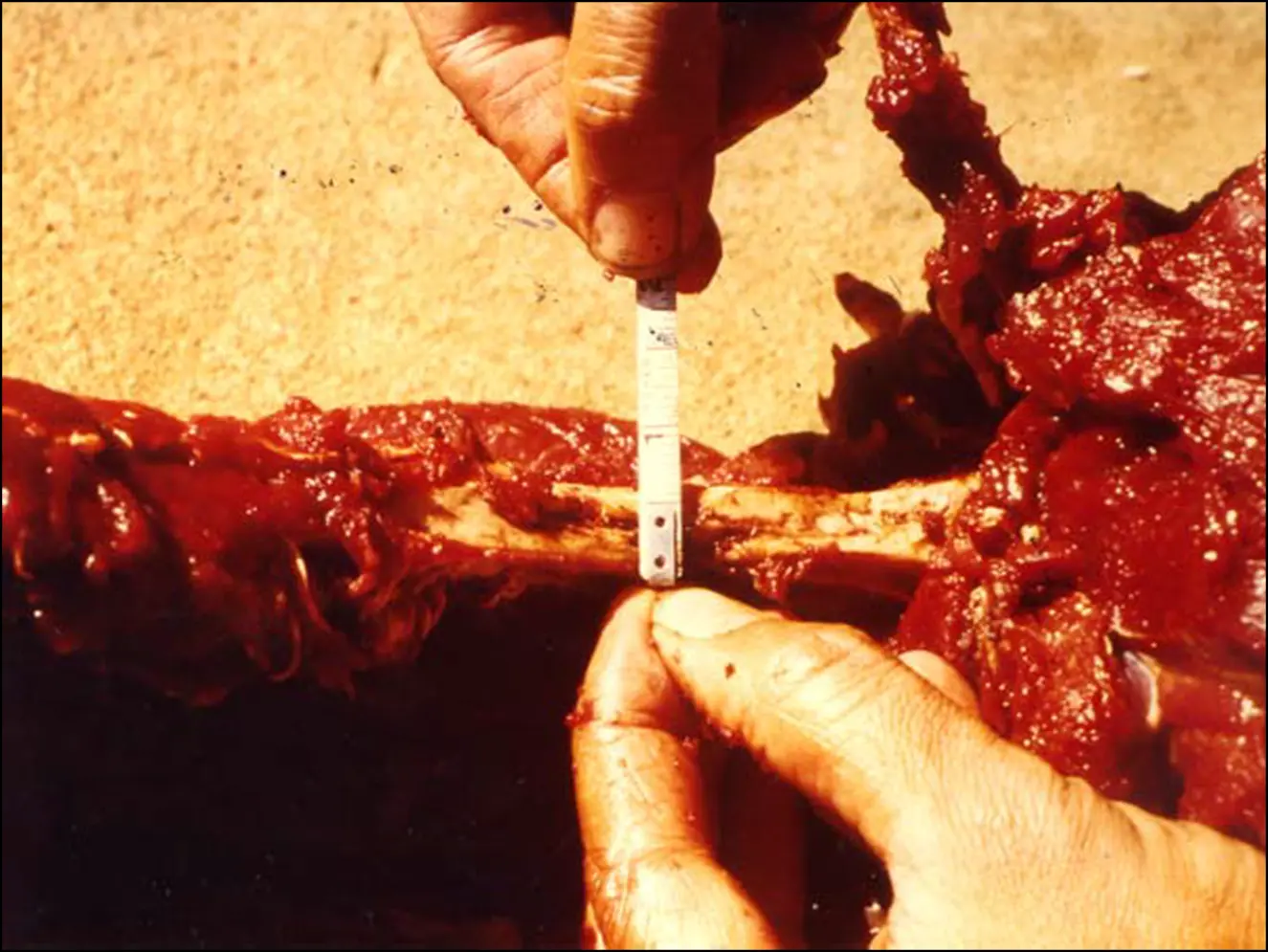 Photo 15
Photo 15
Shown in Photo 15 is the scapula from the largest zebra stallion I've ever taken. It's just over 5/8" thick. No hole here; a very big chunk of the scapula was split away by the Modified Grizzly.
 Photo 16
Photo 16
This is as good as it gets. Photo 16 shows the scapula from a record-class wildebeest bull. Only those who have hunted and taken them can fully appreciate how tough and heavily built a big wildebeest bull is! Pound for pound they are far tougher than buffalo, and their shoulder bones are more than the equal of any elk or moose. The point of arrow impact is indicated by the blue arrow. Note not only the extent of the bone split, but the multiple large chunks of bone broken away. This was also the result of a 1" wide Modified Grizzly.
A point worth noting is that the surface area of the broadhead's face (the blade-flat) has an effect on bone splits too, but there are many trade-offs. The greater the surface area of the broadhead's face, the faster forming and larger the bone split will be - if it occurs. That's because the blade's surface area transmits the bevel-induced torque across a larger area of the bone … and that's where the trade-offs begin.
To split any given bone, a specific level of force must be applied per given square area of the bone. If the blade's surface area is too great, the level of bevel-induced torque force may become too dissipated (spread over too large an area) to be of sufficient strength to cause a bone break.
A bigger broadhead requires more 'raw force' to penetrate the bone. Remember that the rotation, and its associated torque force, depend on the angle and surface area of the bevel that's in contact with the bone; not the blade's surface area in contact. For maximum bone-splitting effect the goal is to have, at any given instant, as much bevel area as possible in contact with the bone; in relation to the amount of blade surface area in contact. The key is to balance the amount of torque force the bevel can generate with the amount of blade surface area being used to transmit that force to the bone. It's because of this 'balance' that my favorite broadhead design is the Modified Grizzly. Outcomes indicate it causes big bone breaks more frequently than either the 190 Grizzly or the Grizzly Extreme; it has demonstrated better balance at the arrow-force levels I commonly use in my hunting.
Now, let's look at the single-bevel's soft-tissue effects. Many seem to place an inordinate amount of importance on the size of the 'exit hole in the skin', with a firm belief that it means more blood 'on the ground'. Thanks to the assistance of Ray Hammond, and Suburban Whitetail Management of North Georgia, Inc., it appears there will, in a couple more years, be enough blood trail data, uniformly graded under strict protocols, to offer definitive answers as to whether the size of the 'hole in the skin' really makes any significant difference in the degree of blood-trail observed. If there is any 'average difference', I'll conjecture that it will be very, very small indeed.
All data accumulated so far indicates that the degree of blood trail depends only on:
(1) Location of the entrance wound
(2) Presence or absence of an exit wound
(3) The location of any exit wound
(4) What organs did the arrow hit in between. So far the frequency of occurrence of the various degrees of blood trail appears pretty evenly distributed among all broadhead types; for 'like hits' under 'similar conditions' (terrain, ground cover, and weather).
Among early data, it appears that one of the biggest factors in the degree of blood reported is the level of tracking/trailing experience of those involved. The more experienced the hunter/tracker the higher their 'average observed' blood trail rating seems to be. 'Experience' is based on the number of animals successfully bow-killed or, in the case of professional guides and trackers, their experience at spooring hit animals. Is there a clue here as to why the degree of blood trail observed varies so much in the anecdotal stories one often hears? Time will tell. The blood-trail reporting protocols consider not only the quantity of blood seen but the consistency, characteristics, and length of the blood trail, as well as shot placement, equipment used, exit wounds and placement, terrain type, ground cover, weather conditions, follow-up technique used and the experience level of both the hunter and the most experienced person involved in the recovery.
All the above notwithstanding, it's worth noting that the rotation a single bevel induces also has an effect on the size of the 'hole in the skin'. Remember how it was mentioned that pliable mediums tend to be compressed or 'pushed aside' by the bevel-induced rotation? It's not uncommon for skin to show this tendency too, especially on arrow-exit. Single-bevel broadheads commonly cause a much larger exit wound through the skin than does a comparable-width double-beveled broadhead. Indeed, it's frequently wider than that left by the wide-cut double-bevel broadheads. As the broadhead exits the skin, its twisting motion commonly results in an L-shaped exit wound, with a total cut-width far exceeding the broadhead's width.
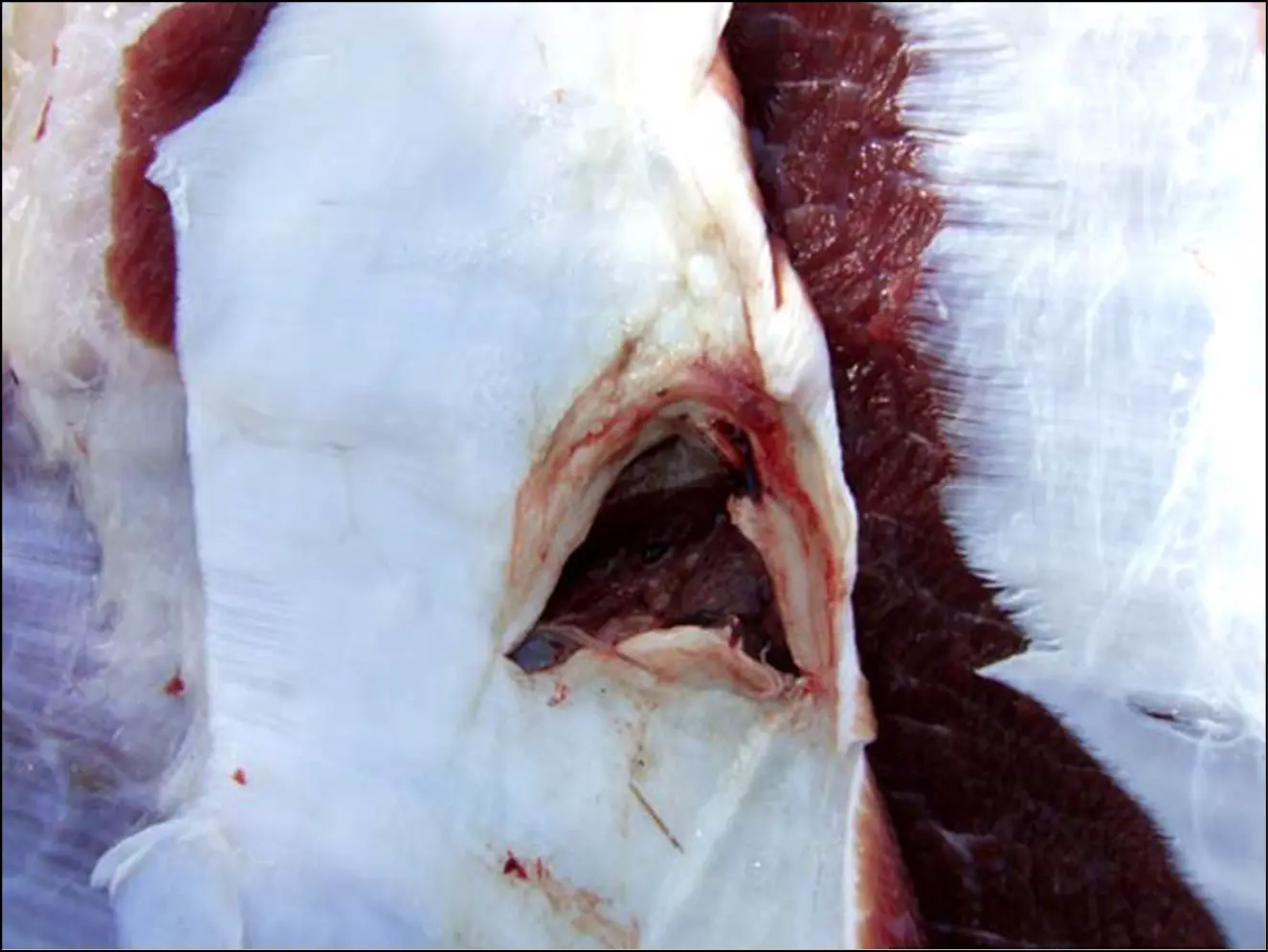 Photo 17
Photo 17
Photo 17 shows the flesh side of an exit wound on one of the trophy-size buffalo bulls, from the 2007 testing. This exit wound was made by a 1" wide Modified grizzly on an Internally Footed Extreme FOC arrow. As a size gauge, the hide shown has a thickness of approximately 1". It wasn't until testing the fully penetration-maximized Internally Footed Extreme FOC arrows that this feature showed up in the buffalo testing. Prior to that, there weren't any significant exit wounds to look at! This hole measures 2" wide, "as the crow flies". Around the bend, it's even bigger!
The L-shaped exit isn't at all uncommon with thin-skinned animals, but rarely are they quite as dramatic as the one shown above. I'd conjecture that the very fact that a buffalo's skin is so thick, tough, and highly fibrous was a big factor. It's likely that there was significant 'spiraling' of the skin around the broadhead as it rotated while penetrating the hide, and before the skin was completely sliced through. Remember, just like in bone, the Modified Grizzly would have been trying to rotate through a large arc during the time its 3-1/8" long blade was passing through the off-side skin!
Unlike entrance-side skin, there's little to prevent the off-side skin from being stretched away from the underlying tissue as the broadhead passed through. If you've ever seen any of Dr. Frank Chamberlin's high-speed photos, taken at Aberdeen Proving Grounds, of a bullet exiting off-side skin of goats, pigs, and mules, you'll know exactly what I mean. It was common for the skin to distend nearly a foot away from the underlying tissues before the bullet exited. Even with a cut-on-impact broadhead, skin gets 'pushed up' a lot before the pressure is sufficient to cut through. Just try pushing your broadhead through a piece of moderately-taut fresh hide and see how far it stretches out before it's pierced!
Does this tendency to 'push' and 'twist' pliable tissues mean a single-beveled broadhead pushes meat, blood vessels, and lung tissue aside, rather than slicing them? Not at all. Try winding some spaghetti around a sharp knife blade. After it's 'wound up', what happens if you push the knife's blade forward while also rotating it, so as to keep the spaghetti strands 'wound up'? The spaghetti gets cut, and far more of it ends up being cut than if you simply ball that spaghetti up equally tight and push the sharp knife straight through! Dissections of single-bevel broadhead wound channels show some of the same effects.
One easy way to see this difference is to try your broadheads against a piece of loose cloth. First, try the double-bevel. Remember it won't be rotating, so just push it through. Next, try the single-bevel. 'Wind it up' a bit by twisting the cloth around the broadhead, by twisting the arrow clockwise (for a right-hand bevel). Just a quarter-turn (90 degrees) of the broadhead will do. Now, push the broadhead through, remembering to continue to rotate the single-beveled head in the appropriate direction as you push it through. That's what it will actually be doing; continuing to rotate and 'winding up' the pliable tissue until it cuts through. Take a look at the cut shape and the difference in total cut area between the two cuts.
 Photo 18
Photo 18
Photo 18 shows the resulting cut through a shop rag when the cloth is 'wound-up' ¼ turn and arrow rotation continued while the broadhead is pushed through. Do you see the similarity with the buffalo hide exit wound shown above? The total width of the L-shaped cut made by this 1" wide single-bevel broadhead measures 2.25" – almost identical to that shown in the buffalo's hide.
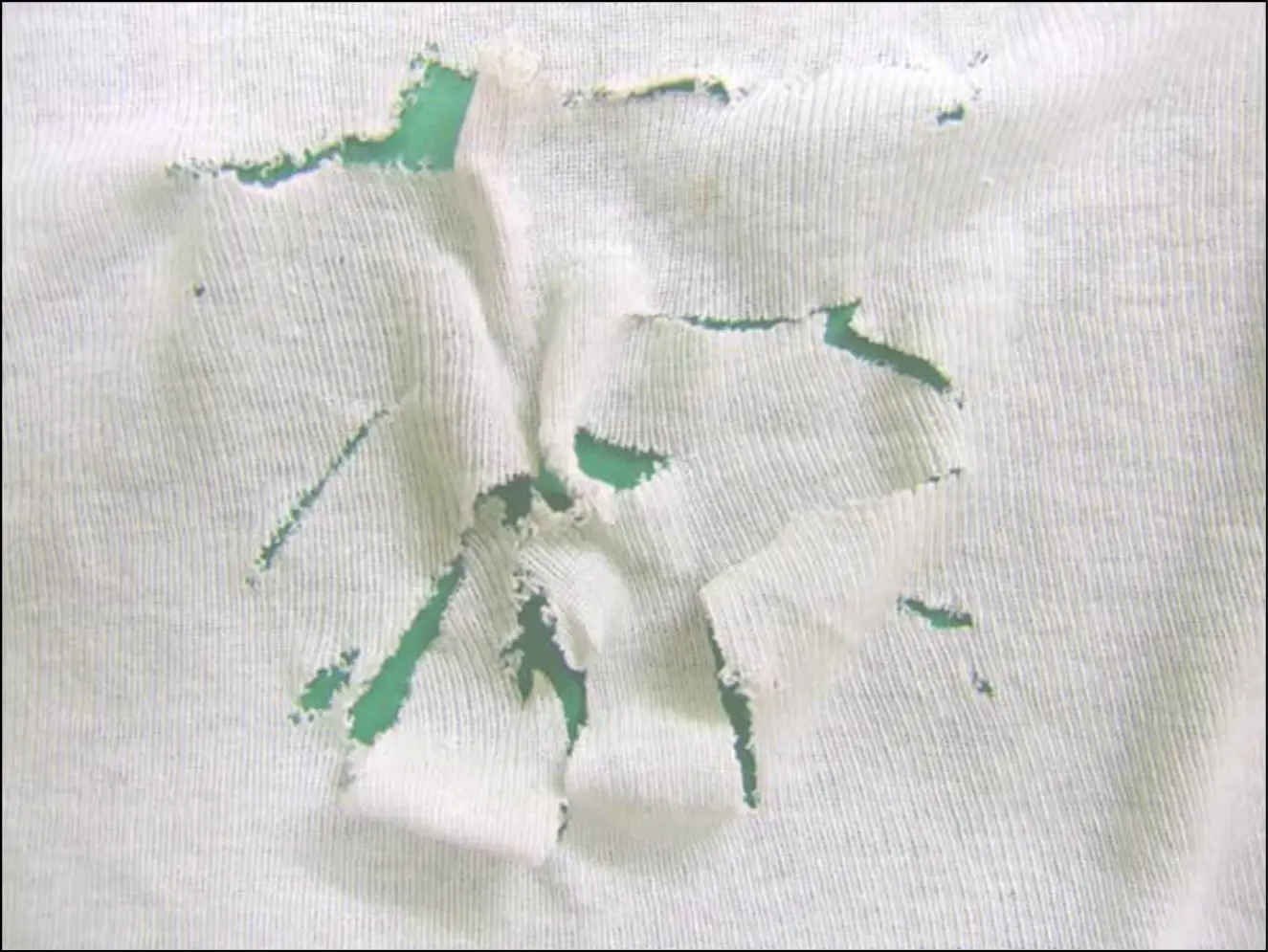 Photo 19
Photo 19
Photo 19 shows what happens if the rag is wound up a half turn before pushing the same broadhead through while continuing arrow rotation. You won't see this 'star-burst' pattern often in soft tissues, but it is often observed in intestinal tissues. It shows up there because, though supported by mesenteric tissue, intestines are far more mobile than other tissues, and are also very fibrous; it's simply easier to get them 'wound up'. This may be one reason I've never failed to recover a gut-hit animal when using a well-sharpened single-bevel broadhead; though I prefer to think it's how I manage the follow-up after the hit.
Besides bone breaks, among the single-bevel wound features that you will routinely see are
(1) Wound channel cuts that are considerably wider than the broadhead's cut-diameter
(2) L- shaped cuts, which commonly appear on internal organs, especially the heart, liver, renal and intestinal tissues
(3) 'mushing' and bruising of lung tissue.
None of these are exhibited with single-bevel broadheads.
A block of ballistic gel can be used to show the 'mushing' effect of a single-bevel broadhead, but you'll need to actually shoot the arrow through it rather than pushing it through slowly. Also note that the temperature of the ballistic gel is a variable factor, affecting its 'tissue simulation' capability; from soft lung tissue to very firm muscle.
If you don't have ballistic gel available, a big block of nice, firm Jello works pretty well too. Yet another suitable target for showing this 'mushing' effect is a ripe watermelon. Whether using ballistic gel, Jello, or watermelon, you'll need to do this demonstration on a bare shaft, and at relatively close range; for broadhead/bare-shaft accuracy reasons. If you don't use a bare shaft, the damage the fletching does in these very soft materials can distort the results.
The 'mushing' and bruising seen in lung tissues is why you'll sometimes hear Ray Hammond refer to how the single-beveled El Grande he uses has "scrambled the lungs" on one of those huge Georgia pigs he's so fond of skewering! You can learn a lot about how different broadheads perform by carefully observing the type and degree of tissue damage they cause; something most bowhunters fail to take advantage of.
To see the difference a single bevel makes, you can try these simple tests yourself. Or, better yet, just shoot a few animals and take a close look at the entire wound channel to see what's happened. On wound dissections, a single-beveled broadhead exhibits a clearly noticeable increase in tissue damage over a double-beveled head.
There are also other, more subtle advantages to having a single bevel on your broadhead. It's easier to get a thinner (ergo, sharper) edge with single bevels. The 25-degree bevel I use represents the total edge-bevel angle; because the other side has a zero-degree bevel. To get an equally thin double-beveled edge you'd have to sharpen each side at 12-½ degrees.
The Pro Big Game has such an angle – and it's very hard to work with since all sharpening has to be done lengthwise to the blade; you can't get anywhere near that 'flat' angle working across the ferrule.
Because of the much thinner edge (at any given sharpening angle), single-bevel broadheads do need to have harder steel to prevent the edges from rolling. I once thought R49 represented the minimum hardness needed for a good single-bevel, but subsequent testing indicates that R52 to R55 represents the minimum hardness for peak performance and edge durability. Yes, higher broadhead hardness means more work sharpening them, but it also means they hold their edge better; they start out sharper and remain sharper throughout penetration. And, no, at these hardness levels, it doesn't result in a brittle blade. All the
190 Grizzlies I've ever had tested (and that's a bunch) have shown between R52 and R55, and I've never damaged a single one on any tissue; either when hunting or during testing. They are definitely hard enough to hold their edge and not so brittle they're prone to breakage - at their thickness.
What other advantages does a single bevel give you? Because of its thinner edge, even at equal sharpness, it will slice deeper than a double-bevel; at any given level of tissue tension against the blade's edge. Why? The bevel's long slope means the edge has a higher mechanical advantage. This means it can do more 'work' with whatever force is applied to it; ergo, it slices equally well with less force than an equally-sharp double-bevel, or better at the same level of force.
Single bevels also make thinner and cleaner cuts. That's one reason why both wood planes and carpenter's hatchets have single bevels; they easily cut-away beautiful thin curls, and with less force than you'd have to use with a double-bevel.
Tissue tension against a cutting edge is one of the many factors that affect the degree of cut achieved. All broadheads enhance the tension of soft tissues against the blade's cutting edge; the wedge effect of the blade and ferrule contour assures that. These features force the tissue apart, tensioning the tissue and making it easier to cut; exactly like the difference between trying to slice through a loose rubber band and one that’s taut. But a rotating broadhead not only has these tensioning features, but it also increases tissue tension by virtue of the spreading effect the rotating blade-face exerts on them. More tissue tension, regardless of how it's created, equals a better and more efficient cutting action.
And, not to be overlooked, a thin rotating edge results in slicing more of the blood vessels at an angle. This means many of the severed blood vessels will be cut on a bias, opening a larger surface area of the vessel and making it harder for coagulation to stem the blood flow. Yes, blood vessels run at all sorts of angles, and a non-rotating double-beveled blade also cuts many on a bias; but not nearly so many as the rotating single-bevel does.
If you doubt that broadhead rotation results in more 'bias-angle cuts', go back and try both edge types on a big 'glob' of spaghetti; remembering to rotate the single-bevel; and then look closely at the severed ends of each strand and count them! It's purely a mathematical probability thing. Having multi-dimensional 'random variables' results in an increased probability the cut won't be perpendicular. The spaghetti's (or blood vessel's) position is relatively static, but the single-bevel blade is both moving forward and simultaneously subtending an arc of rotation while the cut is being made.
The end result of the increased 'chance encounters' between the static blood vessels and rotating cutting-edge is more vessels being cut on the bias; with freer-flowing hemorrhage from more of the vessels severed, and cuts that are less likely to be sealed off by coagulation. The smaller the blood vessel involved, the greater the likelihood you've created a cut that will continue to bleed freely.
Not to leave the wrong impression, you won't be able to see every commonly occurring single-bevel effect on every shot into every animal. However, after you've examined a few, you'll find these features present. Most pronounced, and most easily seen, is the difference in splitting the long bones; and the resulting greater outcome penetration.
When using a single-beveled broadhead, remember to always make the arrow's rotation in flight match the bevel-induced rotation. This means right-wing fletching with a right single bevel, like the Grizzly; and left wing with the left bevels, such as the Abowyer. If you fail to do this, a double-beveled 'like-broadhead' will out-penetrate the single bevel. Why? Because, by mixing arrow rotation in flight and that the bevel induces after the arrow impacts, you've set up a situation where the arrow not only has to stop its rotation on impact, it has to change the direction of rotation and accelerate the rotational rate in the new direction. That uses up a lot of the arrow's energy, directly reducing the arrow force (momentum) available for penetration.
Hopefully, this information will lift some of the shroud of mystery surrounding how and why single-bevel broadheads work, and why those of us who use them regularly are such strong proponents. The demonstrated lethality benefits of single-bevel edges are both numerous and significant. Thank you, Harry. I had many doubts when you first told me what single-bevel broadheads could do … but not anymore!

